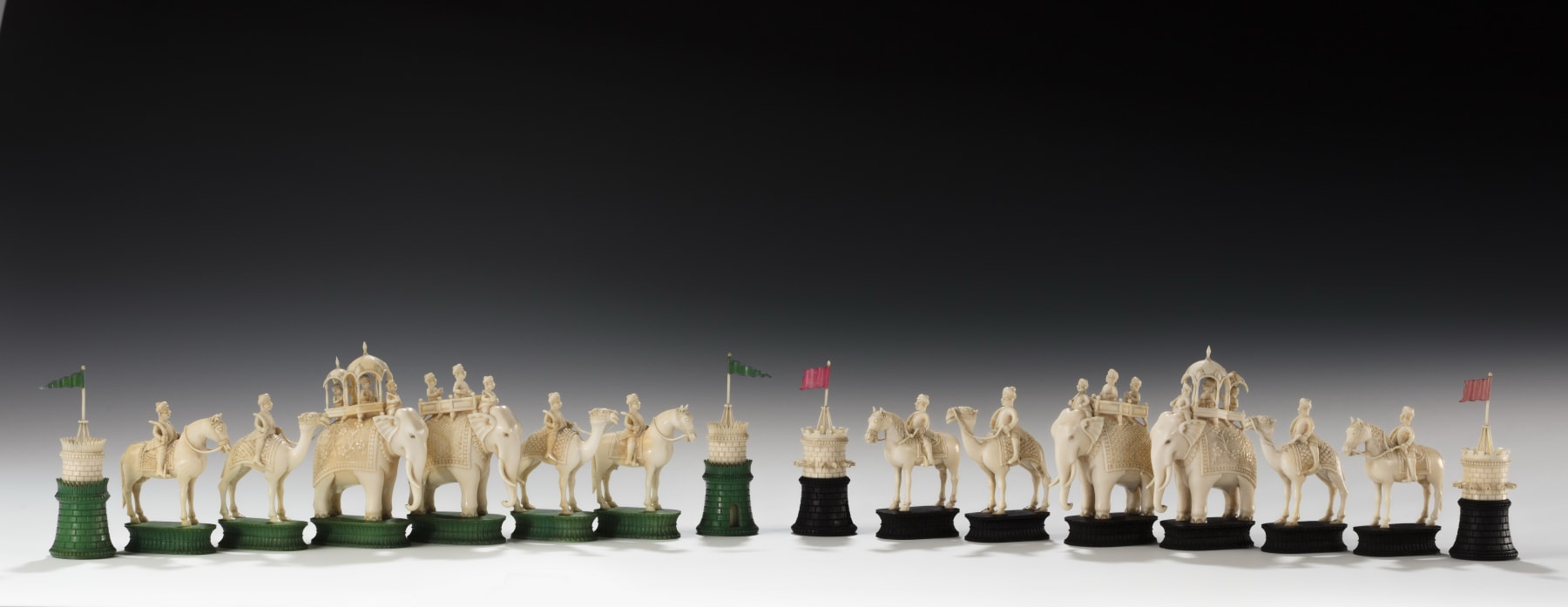Anglo-Indian 18th Century Carved Ivory 32 Piece Chess Set
9.5 x 3 x 6 cm
Further images
A set of chess pieces set on green stained bases on one side; and on black stained bases on the opposing side. The Kings and Queens are depicted as elephants with Royal Howdahs on which three figures are seated – two with canopies and two with the central figure carrying a parasol; the Bishops are depicted as mounted camels; the Knights are depicted as mounted horses; the Rooks are depicted in the form of round towers – the pair on the green bases flying green flags, and the pair on the black bases flying red flags; and the pawns are depicted as foot soldiers.
Pratapaditya Pal, in his essay ‘Something Old, Something New: Ruminations on Indian Chess’, states that: ‘[a]s is now agreed by most scholars, the game was invented in the subcontinent, from where it was introduced to Western Asia and then to Europe… Three types of evidence can be brought to bear upon the Indian origin of the game: the structure of the game itself, literary allusions, and archeological evidence.’ (Pratapaditya Pal, ‘Something Old, Something New: Ruminations on Indian Chess’, in ‘The Art of Play: Board and Card Games of India’ (Andrew Topsfield (ed.), Marg Publications, 2006), pp.32-43.)
Amin Jaffer remarks on Murshidabad’s significance as a centre of political power and patronage, which dates to the early eighteenth Century. He considers the ‘two alternative theories for the origin of ivory carving at Murshidabad’ in his book ‘Furniture from British India and Ceylon: A Catalogue of the Collections in the Victoria and Albert Museum and the Peabody Essex Museum’ (Timeless Books, New Delhi, 2001). The first ‘suggests that it began in the early eighteenth century and that carvers themselves were hereditary image-makers of the Bhaskar caste who migrated to Murshidabad from Sylhet in response to the new court.’ The alternative explanation, ‘based on oral tradition, is that ivory was first worked at Murshidabad by a Delhi ivory carver, and that his work was copied by a locally based Bhaskar and his son… He engaged apprentices…, and it was allegedly through their descendants that the craft was established in the region.’ (ibid, p.238). Jaffer states that: ‘Ivory carving from Murshidabad consisted principally of small-scale objects such as combs, fly-whisk handles, chessmen and caskets… By 1811 the region was already known for its ‘inimitable ivory work’, which was simply sold by local vendors to European travellers in the region.’ (ibid, p.238-9).
A very similar chess set, also originating from Murshidabad, c.1790 and also comprising thirty-two pieces of carved ivory on black stained bases on one side and on green stained bases on the other, is housed in the V&A’s collection (V&A Museum number: IM.42:1 to 32-1910; http://collections.vam.ac.uk/item/O455143/chess-set-unknown/). The key difference between the two sets is that, in the V&A’s set, the Bishops are depicted as buffalos on the black side and as mystical wild cats on the green side, in place of the mounted camels in our set; and the Knights are depicted as horses on the black bases but as camels on the green bases. A note on the file of the set in the V&A’s collection, written by C. Stanley Clarke and dated 11 July 1910, describes them as: ‘Figure pieces of ivory quaintly carved in representation (A) of H.E.I.C. [Honorable East India Company] troops – officers in Georgian costume on elephant and horseback, and sepoy soldiers: (B) probably of the troops of Tippu Sultan of Mysore. Made at Berhampur, Murshidabad, Bengal, during the second-half of the 18th century, probably about 1790.’ A note on the V&A’s website states that there is no corroborating evidence for the identification of (B), or of their place of origin, and no provenance information on the file (see URL above).
Another similar set exists in the collection of the State Archaelogical Museum, West Bengal.








